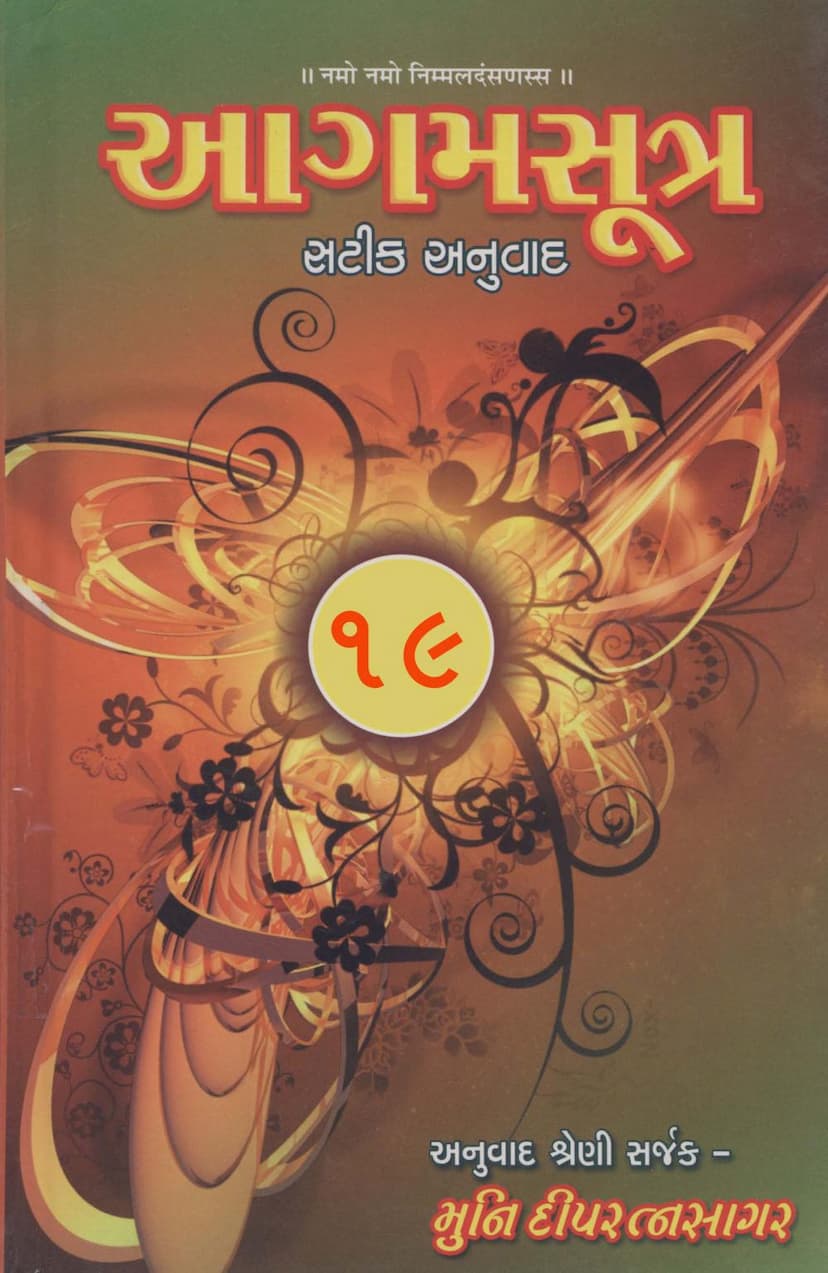Agam Satik Part 19 Jivabhigam Sutra Gujarati Anuwad 3
Added to library: September 1, 2025

Summary
This document is the Gujarati translation and commentary of the Jivabhigam Sutra, which is an Upanga (secondary scripture) in Jainism. It is Volume 19 of a larger series of Agam Sutra translations.
Here's a breakdown of the key aspects presented in the provided pages:
1. Title and Attribution:
- Book Title: Agam Satik Part 19 Jivabhigam Sutra Gujarati Anuwad 3 (Agam Sutra with Commentary, Part 19, Jivabhigam Sutra, Gujarati Translation 3)
- Author(s): Dipratnasagar, Deepratnasagar
- Publisher: Deepratnasagar
- Catalog Link: https://jainqq.org/explore/009010/1
- Translation Series Creator: Muni Dippratnasagar
2. Content Overview of Jivabhigama Sutra (Volume 19):
- This volume is part 19 of the "Agam Satik Anuwad" (Commented Agam Translation) series.
- It specifically covers the Jivabhigam Sutra, which is identified as the third Upanga.
- Content Breakdown:
- Pratipatti 1 (in Part 1 of the Agam Anuwad series): Jambu-dvipa and related island-ocean discussions.
- Pratipatti 4 to Pratipatti 9 (covered in this volume): The complete "Sarvajiv Pratipatti" (Discourse on all Jivas).
- The translation includes commentary based on Malayagiri's commentary.
- The text also mentions the potential existence of a Churni on this Upanga, though its printed availability is not known.
3. Acknowledgements and Financial Support:
- The document lists numerous individuals, organizations, and Jaina Sanghs (communities) that provided financial support for the translation and publication of this series. This highlights the collaborative effort and community support behind this extensive project.
- Key figures and lineages of Acharyas (spiritual preceptors) are mentioned, including Acharya Shri Hachmchandrasurishwarji, Acharya Shri Ichakchandsurishwarji, and Acharya Shri Devendrasagarsurishwarji, indicating a lineage-based spiritual tradition supporting the work.
4. Publisher's Publications:
- Pages 8 through 12 detail various other publications by the same publisher, likely related to Jain Agams and literature. This provides context for the scope of their work and includes titles like:
- Agam Gujarati Anuwad (Agam Gujarati Translation)
- Agam Sutrani Satik (Agam Sutras with Commentary)
- Agam-Vishay-Darshan (Jain Agam Subject Index)
- Agam-Namkosh (Jain Agam Name Dictionary)
- Agam Sutra Hindi Anuwad (Agam Sutra Hindi Translation)
- Agam Katha Anuyog (Jain Agam Narrative Literature)
- Agam Matajan Vidhi (Jain Agam Rituals)
- And various grammatical, devotional, and ritualistic texts.
5. Detailed Content of Jivabhigam Sutra (Specific Sutras):
- Sutra 185: This section begins a detailed explanation of why Jambu-dvipa is called Jambu-dvipa. It describes the geographical location of the Uttara-kuru region, its dimensions (length, width, shape), and the characteristics of its inhabitants.
- It describes the flora, the beautiful land, the characteristics of the humans, their lifespan, their food sources, their physical attributes, their dwellings (tree-like structures), and the absence of suffering, strife, and negative emotions.
- It details various types of celestial beings and their interactions, the names of mountains, rivers, and the significance of certain trees like the Jambu tree.
- The description of the geographical features is highly detailed, including measurements in Yojana, Dhausa, etc., and the composition of mountains (e.g., golden mountains).
- The human inhabitants of Uttara-kuru are described as exceptionally beautiful, virtuous, and free from the afflictions of the human realm in other continents.
- Sutra 186: Discusses the Yamak Mountains (which seem to be a pair of mountains) and their associated deities and celestial beings.
- Sutra 187: Describes the Nilavanta Darha (a large lake or pond) and the celestial beings and structures associated with it.
- Subsequent Sutras (188-296): The text continues to describe other geographical features, celestial beings, and their attributes within the Jambu-dvipa and surrounding regions. This includes details about:
- Chandra-dvipa, Surya-dvipa: Islands associated with celestial beings related to the moon and sun.
- Lavana-samudra: The ocean of salt water, its dimensions, gates, and the deities residing there.
- Dhataki-khanda, Kalod-samudra, Pushkar-dvipa, Varuna-dvipa, Kshira-samudra, Dhrita-samudra, Kshauda-samudra, Nandishwara-dvipa, Nandishwara-samudra, Arun-dvipa, Arunod-samudra, Arunavar-dvipa, Arunavara-samudra, Kundala-dvipa, Kundala-samudra, Ruchaka-dvipa, Ruchaka-samudra, Pushkarod-samudra, Pushkara-vara-dvipa, Pushkara-vara-samudra, and finally, the Self-Created Ocean (Swayambhu-ramana).
- For each of these geographical entities and the associated deities, the text details their dimensions, formation, the celestial beings residing there, their lifespan, their residences (vimanas), and their characteristics.
- It explains the astronomical movements of celestial bodies (sun, moon, planets, stars) and their relationship to the cosmos and human destiny.
- The text also delves into the classification of souls based on the number of senses (Jivas), the concept of paryapti (fulfillment of life-functions) and aparyapti (non-fulfillment), and the lifespan of beings in different realms.
- It discusses the pudgal parinam (transformation of matter) and its relationship to senses.
- The document also touches upon the nature of celestial beings (Vaimanika Devas), their different classes (like Bhavanapati, Vyantara, Jyotishka, Vaimanika), their lifespans, their abodes (vimanas), and their powers.
- It also touches upon the karmic aspects and the influence of celestial bodies on human life.
In essence, this volume of the Agam Satik Anuwad provides a detailed geographical, cosmological, and philosophical exposition based on the Jivabhigam Sutra, as interpreted by Malayagiri. It aims to systematically explain the nature and characteristics of all souls (Jivas) and their relationship with the physical and celestial realms within Jain cosmology.